Forestry mulching
Forestry mulching is a land clearing method that uses a single machine to cut, grind, and clear vegetation.
A forestry mulching machine, also referred to as a forestry mulcher, forest masticator, or brushcutter, uses a rotary drum equipped with steel chipper tools (“teeth”) or blades to shred vegetation.[1] They are manufactured as application-specific tractors and as mulching attachments (“mulching heads”) for existing tracked and rubber-tired forestry tractors, skid steers, or excavators.
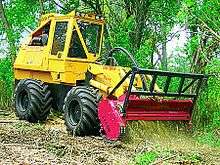
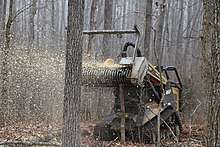
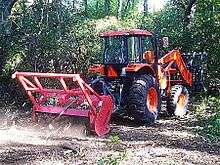
Heavy duty forestry mulchers can clear up to fifteen acres of vegetation a day depending on terrain, density, and type of material. Forestry mulchers are often used for land clearing, right-of-way, pipeline/power line, and wildfire prevention and management,[2] vegetation management, invasive species control,[3] and wildlife restoration.[4]
Applications of forestry mulching
Right-of-way clearing and maintenance
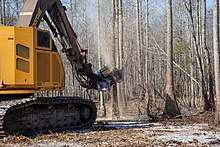
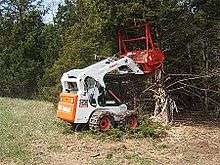
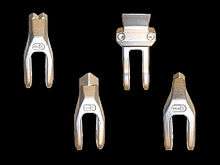
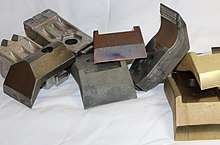
Forestry mulching is used in the right-of-way clearing and maintenance for roads, highways, pipelines, and other utility lines. This process often requires complete removal of standing trees, stumps, and vegetation.
Land clearing
Forestry mulchers can be used in commercial and residential land clearing projects such as site preparation and development, cutting and clearing brush, nature and recreational trail creation,[5][6] and seismic exploration.[7]
Wetlands and riparian habitat conservation
Forestry mulching has become popular among nonprofit riparian conservation organizations, government agencies, hunt clubs, and private land owners in attempts to maintain habitats for pheasants, doves, elk, deer and various other animals. Maintaining an animal habitat encompasses several different aspects: food, water, shelter, and space, and there are many products that can help reclaim and maintain wildlife habitats for these animals.[8]
- Food: Forestry mulchers and forestry mowers are often used for removing underbrush and invasive species, such as buckthorn and multiflora rose, in order to allow the rejuvenation of grasses and other food sources.
- Water: Forestry mulchers and tree shears can be used to restore water source access that has been blocked due to tree and understory growth, allowing animals to access the water.
- Shelter and space: Mulching can remove invasive underbrush that prevents the growth of the grasses required by certain animals for shelter, breeding, escaping the summer heat, and protecting themselves from cold temperatures.[9]
Invasive species control
Some common invasive plant species such as tamarisk (salt cedar), Pinyon-juniper (pj), Russian olive, Juniperus_virginiana, buckthorn, and multiflora rose [10] can invade a natural habitat, soak up a tremendous amount of ground water, and need to be removed to reestablish the native habitat or to preserve the water table.[11] Invasive insects such as pine beetles can also devastate forests, leaving behind rotting trees with diminishing timber value and that may become falling hazards if they lose their ability to stand up against wind.[12]
Proactive mulching can reduce stress on trees caused by crowding, making them less susceptible to attack from invasive species. Mulching invasive species in place can control the spread of invasive plants, insects, and fungus. The mulching action tends to discharge the material downward and within a reasonably confined area, versus other methods such as rotary cutters that may laterally disperse pine beetles or other invasive species into neighboring healthy trees.
Wildfire prevention and management
- Proactive mulching: Mulching reduces the potential for wildfires by eliminating small leafy plants, fallen or rotten trees, and other fuel sources.[13] If left untreated, these fuel loads increase potential for fire, increase the heat intensity, and serve as fire ladders that enable fire to elevate quickly to the tops of trees which is where a fire can spread most quickly. Mulching can also be used to create a coarse grind finish that can create a more ideal controlled burn.
- Reactive mulching: In addition to proactive thinning of vegetation to mitigate fire fuels, forestry mulching can be used for reactive cutting of lines (fire breaks) on active fires. Larger forestry mulchers leave minimal cleanup requirements and can help reduce the overall costs of active fire mitigation.[14]
- Cleanup: After the fire is out and cleanup efforts are under way, tracked forestry mulching machines, mulching attachments, and an excavator with a mulching attachment can provide a top layer of mulch to prevent soil erosion on slopes and minimize water pollution.
Advantages of forestry mulching
By processing trees and other vegetation where they stand, mulching machines eliminate many of the steps involved in land clearing such as site prep, cutting/felling/hauling, and site cleanup.[15] [16]This also eliminates the need for multiple machines such as a bulldozer accompanied by some combination of excavators, tree shears, wood chippers or grinders, and hauling equipment. On simpler jobs only one mulching machine is required, reducing fuel requirements and emissions.[17]
Some mulching machines also have the ability to operate on steep slopes and in small or tight areas, in poor ground conditions, and in wet or snowy weather.[18]
Mulching machines are capable of clearing land of unwanted trees and brush with limited disturbance to soils or desirable vegetation.
Traditional land clearing methods often present an increased risk of erosion by pushing over trees, uprooting the stump and roots, and substantially disturbing soils. In contrast, mulching the vegetation leaves the soil structure intact. The mulched material can be left on the ground and will act as an erosion barrier while returning nutrients back into the soil through decomposition. Over time, grass will naturally grow through the mulch and can be maintained with mowing.
Disadvantages of forestry mulching
Depending on the size and orientation of the mulching head, forestry mulchers can only fell smaller trees. Mulchers with a mulching head that rotates about a vertical axis can typically handle trees up to 6-8 inches in diameter, while mulchers with a mulching head that rotates about a horizontal axis can handle trees up to 30 inches in diameter. Some excavator mulching attachment are equipped with a tilting bracket that significantly reduce the risk of felling bigger trees with a Mulching head. Mulching trees at the upper end of this size range can be dangerous for both the equipment and the operator.[1] Mulching areas with a variety of vegetation and terrain may require multiple pieces of equipment, including tracked mulching machines, excavator mulchers, and skid steer tractors equipped with mulching attachments.
Rocks and stones cannot be processed or moved by the machines, and the teeth grinding against rocky ground can both wear them out and cause a fire hazard. Blades, hammers and teeth are replaceable and considered wear parts. Smaller rocks and other debris can be thrown through the air, and while these are usually deflected by a protective shroud, they can present a danger to the operator and surrounding people and structures.[1]
Even for the largest machines, mulching is only effective when less than 25 tons of vegetation or 100 trees are present per acre.[1][19]
Although mulching is significantly faster and less labor-intensive than land clearing by hand, it requires the site to have road access for fueling and maintenance.[19]
References
- "Mulchers (Also referred to as Masticators or Brushcutters)". Forest Operations Equipment Catalog. Forests and Rangelands. Retrieved 7 July 2013.
- A.E. Araiza Arizona Daily Star (2010-05-06). "Mechanical grinder quickly creates firebreaks in Oracle". Azstarnet.com. Retrieved 2013-06-28.
- "Features Vol 49 no 6 - Dwarf Mistletoe – The Quiet Kiss of Death". Landandwater.com. Retrieved 2013-06-28.
- "Wildlife in "Edge Areas" Thrive When Habitats are Kept in Check". Forconstructionpros.com. 2011-01-04. Retrieved 2013-06-28.
- http://www.govengr.com/ArticlesJul08/Mulchers.pdf
- "Camp Rotamer ready to host open house". GazetteXtra. Retrieved 2013-06-28.
- "Seismic". Fecon. Retrieved 2013-06-28.
- "Tamarac National Wildlife Refuge, Becker County, Minnesota | Woodcock population and young forest habitat management". Timberdoodle.org. Retrieved 2013-06-28.
- "cattails « Pheasants Forever Blogs". Pheasantblog.org. 2010-11-30. Archived from the original on 2013-07-23. Retrieved 2013-06-28.
- "Non-native Invasive Freshwater Plants - Salt Cedar (Tamarix) - Technical Information". Ecy.wa.gov. Retrieved 2013-06-28.
- "Russian olive - Invasive species: Minnesota DNR". Dnr.state.mn.us. Retrieved 2013-06-28.
- "Pine Bark Beetles". Arborjet. Retrieved 2013-06-28.
- "Forest Service using cutting-edge technology to fight forest fires - KTRE.com | Lufkin and Nacogdoches, Texas". KTRE.com. Retrieved 2013-06-28.
- Halbrook, Jeff; Han, Han-Sup; Graham, Russell T.; Jain, Theresa B.; Denner, Robert (July 30 – August 2, 2006). "Mastication: A fuel reduction and site preparation alternative" (PDF). Proceedings of the 29th Council on Forest Engineering Conference: 137–146. Retrieved 6 July 2013.
- "Grinding Attachment Provides Efficiency". Construction Equipment. 2008-01-21. Retrieved 2013-06-28.
- "Forestry Mulching - Is it right for you?". KW Land Works - Forestry Mulching and Restoration. Retrieved 2017-03-15.
- "No Burn, No Haul off". Lifescapes-forestry-mulching.com. 2013-05-27. Retrieved 2013-06-28.
- "Innovative technology keeps Canadian contractors working in the woods - The Working Forest, Your #1 source for forestry and forest industry news". Workingforest.com. 2011-07-28. Archived from the original on 2013-06-29. Retrieved 2013-06-28.
- USDA Forest Service, Rocky Mountain Research Station (2004). "Fuels Planning: Science Synthesis and Integration Economic Uses Fact Sheet: 1 Mastication Treatments and Costs" (PDF). Res. Note RMRS-RN-20-1WWW. Fort Collins, CO: U.S. Department of Agriculture, Rocky Mountain Research Station. Retrieved 6 July 2013.